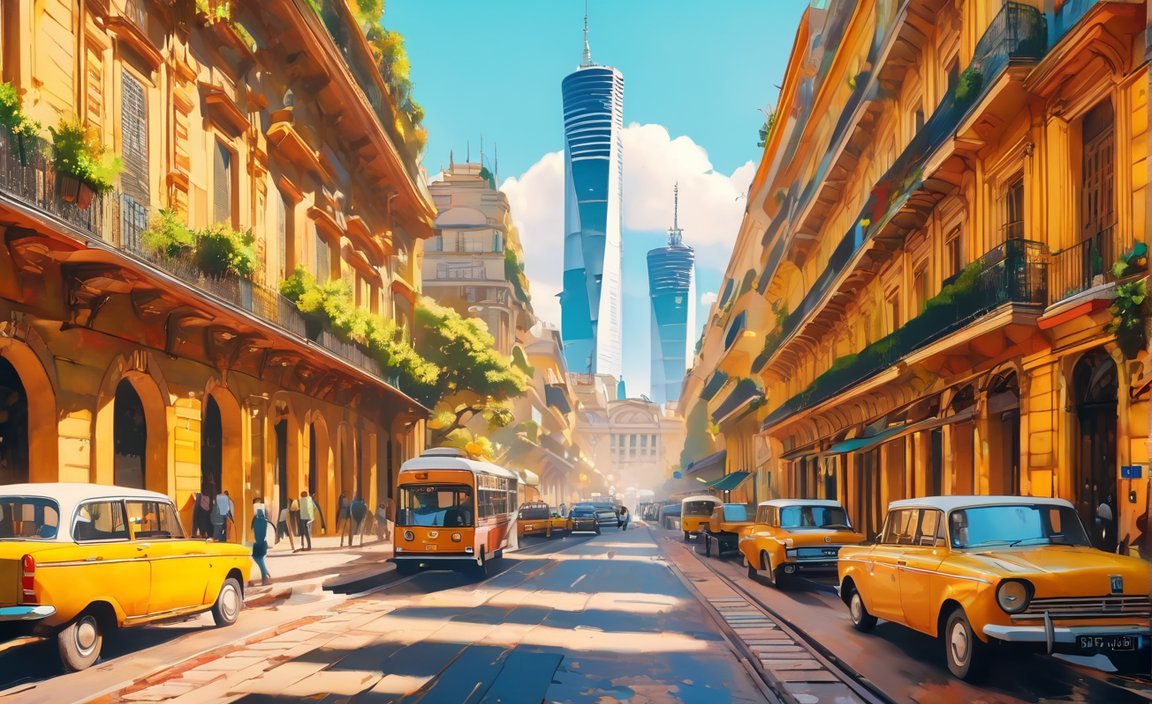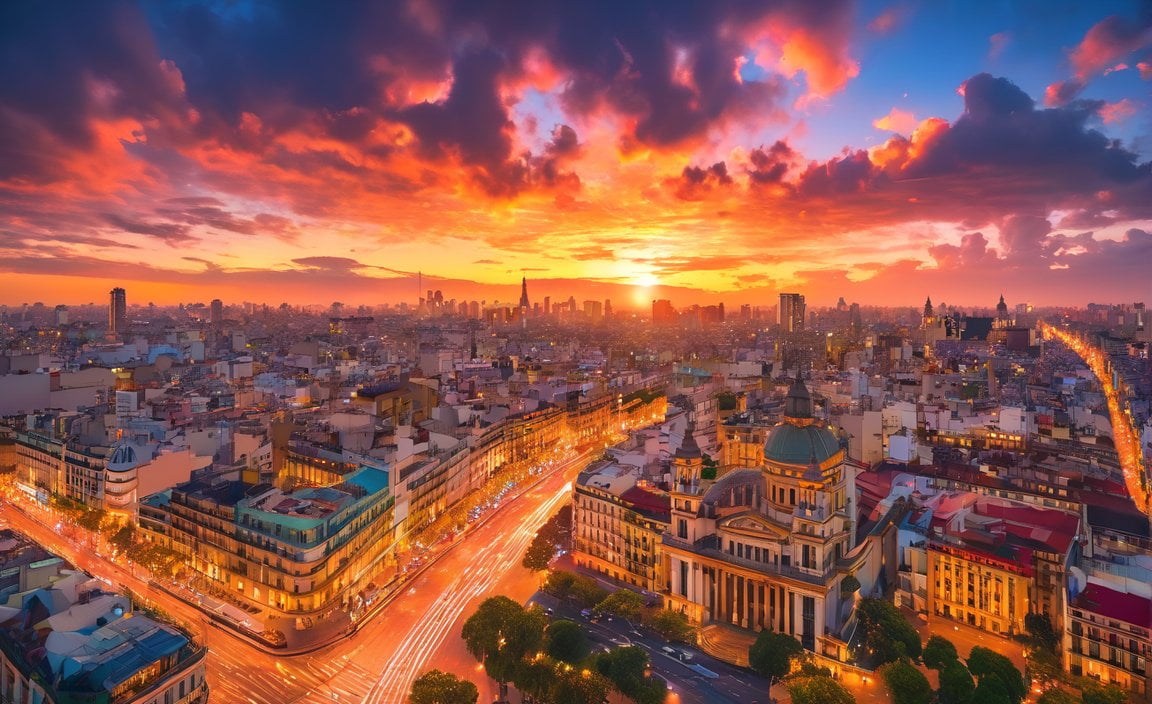Welcome to the vibrant and captivating world of Buenos Aires, where history, culture, and creativity intertwine to create a truly mesmerizing urban tapestry. In this article, we will unveil 10 fascinating facts about the enigmatic capital of Argentina, shedding light on its hidden gems, cultural nuances, and captivating stories. From its rich architectural heritage to its passionate tango scene, Buenos Aires beckons travelers with its undeniable charm and infectious energy. So without further ado, let’s delve into the wonders of this remarkable city and uncover its captivating secrets.
Key Takeaways:
- Buenos Aires has the highest number of therapists per capita in the world, highlighting the city’s emphasis on mental health and well-being.
- Argentina’s public hospitals provide free healthcare for all citizens, ensuring equal access to medical services.
- Breakfast is not a common meal in Argentina, reflecting a cultural difference that may surprise visitors.
- Argentina was the first country in South America to legalize same-sex marriage, demonstrating its commitment to equality and LGBTQ+ rights.
- Buenos Aires boasts the highest number of bookshops per capita globally, making it a haven for literary enthusiasts.
- The city has a large population of cats and dogs, contributing to its pet-friendly atmosphere.
- Tango, often associated with elegance, actually originated in the working-class neighborhoods of Buenos Aires, showcasing the city’s diverse cultural heritage.
- Soccer is not the official national sport of Argentina; it is pato, a traditional game played on horseback.
- Buenos Aires is known as the “Paris of the South” due to its stunning architecture, European-style boulevards, and vibrant cultural scene.
- The Recoleta Cemetery is the most visited attraction in Buenos Aires, renowned for its elaborate mausoleums and as the resting place of famous figures like Eva Perón.
10 Facts About Buenos Aires

Buenos Aires, the vibrant capital of Argentina, is a city rich in history, culture, and intriguing surprises. Let’s delve into ten fascinating facts that unveil the uniqueness of this bustling metropolis:
1. The City of Therapists
Did you know that Buenos Aires has the most therapists per capita in the world? This highlights the city’s emphasis on mental health and well-being, providing its residents with ample resources for support and personal growth[^1^].
2. Healthcare for All
In Argentina, public hospitals offer free services to everyone. This ensures that every citizen, regardless of their financial situation, has access to quality healthcare. This commitment to the well-being of its people is truly remarkable[^1^].
3. A Cultural Breakfast Skip
Unlike many other countries, most Argentines don’t prioritize breakfast as an important meal of the day. This cultural difference might surprise visitors who are accustomed to starting their day with a hearty morning feast[^1^].
4. Celebrating Equality
Argentina made history by becoming the first country in South America to legalize same-sex marriage. This progressive action showcases the country’s commitment to equality and LGBTQ+ rights, making Buenos Aires a welcoming destination for all[^1^].
5. Book Lover’s Paradise
For avid readers, Buenos Aires is a treat. The city boasts the highest number of bookshops per capita in the world, with approximately 734 bookstores waiting to be explored. From cozy, independent shops to grand literary palaces, Buenos Aires has a vibrant literary culture that will captivate any bibliophile[^2^].
6. Furry Friends Everywhere
Buenos Aires has a special place in its heart for its four-legged residents. You’ll find a ridiculous number of cats and dogs roaming the streets, contributing to the city’s pet-friendly atmosphere. Their adorable presence adds an extra touch of charm to the already captivating urban landscape[^2^].
7. Tango: From the Streets to the Stage
Tango, often associated with elegance and sophistication, actually has its roots in the working-class neighborhoods of Buenos Aires. This dance form reflects the city’s unique blend of cultures and is a testament to its diverse heritage. So, get ready to embrace the passion and rhythms of this famous dance during your visit[^2^].
8. Not Just About Soccer
While soccer is undoubtedly extremely popular in Argentina, it may come as a surprise that it’s not officially recognized as the national sport. Argentina’s national sport is pato, a traditional game played on horseback. This fascinating fact showcases the country’s diverse sporting interests and culture[^2^].
9. The Paris of the South
Buenos Aires has earned the title “Paris of the South” for good reason. Its striking architecture, European-style boulevards, and vibrant cultural scene make it reminiscent of the elegant capital of France. Prepare to be enchanted by Buenos Aires’ cultural richness and undeniable elegance[^2^].
10. A Historic Resting Place
Recoleta Cemetery, located in Buenos Aires, is not only a burial site but also an architectural masterpiece. With elaborate mausoleums and the final resting place of famous figures like Eva Perón, it’s no wonder the cemetery is the most visited attraction in the city. Explore the captivating beauty and the stories engraved in each tombstone[^3^].
These ten intriguing facts about Buenos Aires provide a glimpse into the city’s focus on mental health, its cultural richness, and its commitment to equality. From healthcare accessibility to literary culture and unique traditions, Buenos Aires never ceases to enchant visitors with its vibrant energy and captivating stories.
Sources:
[^1^]: 10 interesting facts you should know about Buenos Aires
[^2^]: 10 Things You Didn’t Know About Buenos Aires
[^3^]: 10 Things You Didn’t Know About Buenos Aires | Culture Trip
If you’re looking for the perfect place to retire in Ontario, check out our list of the 10 best places to retire in Ontario. Whether you’re seeking a peaceful waterfront retreat or a vibrant city with plenty of amenities, this list has got you covered. Plan the next chapter of your life in Ontario’s most desirable retirement destinations.
Curious about the fascinating state of Gujarat? Discover 10 interesting facts about Gujarat that will leave you amazed. From its rich history and cultural heritage to its breathtaking landscapes and vibrant festivals, Gujarat offers a unique blend of tradition and modernity. Click here to uncover the hidden gems of this incredible Indian state.
Explore the captivating wonders of Hawaii’s volcanoes with 10 fascinating facts about Hawaii volcanoes. Learn about the world’s most active volcano, the mesmerizing lava flows, and the intense beauty of volcanic landscapes. If you’re a nature enthusiast or simply intrigued by the power of nature, this is a must-read. Embark on an awe-inspiring adventure by clicking here.
The tango: Argentina’s beloved dance
Buenos Aires, the vibrant capital of Argentina, is a city that comes alive with the passionate rhythms of the tango. This beloved dance reflects the rich cultural heritage and captivating history of the Argentine people. In this article, we’ll dive into the intriguing world of the tango and uncover 10 fascinating facts about this iconic dance.
1. Born from the Working-Class Neighborhoods
The origins of the tango can be traced back to the poor and underprivileged areas of the docklands in Buenos Aires. It emerged as a dance born out of the working-class neighborhoods, where people found solace, expression, and connection through movement.[^1^]
2. A Dance of Desire and Emotion
During the early days of tango, Buenos Aires faced a shortage of women, leading to an abundance of men looking for a way to express their emotions and desires. The tango provided them with a platform to convey their deepest sentiments through intricate steps and passionate movements.[^1^]
3. The Tango’s Social Hierarchy
In the eyes of the wealthy upper-class Porteños (as the people of Buenos Aires are known), the tango was once seen as scandalous and unsavory. They regarded it as a lowly dance fit only for the poor. However, as time passed, the tango transcended social barriers to become a beloved part of Argentine culture.[^1^]
4. Underground during Political Unrest
During a period of political turmoil in Argentina from 1955 to 1983, the tango went underground. The government viewed it as controversial and sought to suppress its widespread practice. However, the spirit of the tango could not be extinguished, and it continued to thrive in secret milongas (tango dance halls).[^1^]
5. A Dance of Spontaneity and Interpretation
Unlike formalized ballroom dances, such as waltz or foxtrot, tango incorporates improvisation. It is the first couple dance in Europe to allow dancers to interpret the music and express themselves through spontaneous movements. This freedom and creativity make the tango a dance like no other.[^1^]
6. A Fusion of Cultures
The tango bears influences from both African and European cultures. Dances from the candombe ceremonies of former African enslaved people played a significant role in shaping the modern-day tango. This fusion of cultural elements gives the dance its distinctive flair and rhythm.[^1^]
7. A Dance of Expressive Connection
Originating in both Buenos Aires and Montevideo, the tango was closely linked to the working-class communities of these cities. It was a means for these communities to express themselves, connect with one another, and break free from the constraints of their everyday lives.[^1^]
8. Fusion of Musical Styles
The music of tango is a fusion of various forms from Europe. It combines elements of Spanish flamenco, Italian opera, and Eastern European folk music, resulting in a passionate and unique sound that perfectly complements the dance itself.[^1^]
9. Immersive Experiences in Buenos Aires
If you’re eager to delve deeper into the world of tango, Buenos Aires offers a multitude of opportunities. From dance classes to authentic milongas, you can immerse yourself in the rhythm and soul of this beloved dance. These experiences provide a glimpse into the true essence of Argentine culture.[^2^]
10. Discover the Heart of Tango
The tango is far more than just a dance. It represents the heart and soul of Buenos Aires, capturing the indomitable spirit of its people. Whether you’re a dance enthusiast or simply a curious traveler, exploring the world of tango in Argentina is an experience that will leave an indelible mark on your soul.[^2^]
Key Takeaways:

- Tango originated in the working-class neighborhoods of Buenos Aires, providing an outlet for expression and connection.
- The dance gained popularity due to a shortage of women in the city, allowing men to express their emotions and desires.
- Initially viewed as scandalous by the upper class, the tango transcended social barriers to become an integral part of Argentine culture.
- Tango went underground during a period of political unrest in Argentina but continued to thrive in secret milongas.
- Unlike formalized ballroom dances, tango allows for improvisation and interpretation, making it a dance of spontaneity and expression.
- The tango is a fusion of African and European cultures, resulting in its unique rhythm and style.
- Buenos Aires offers an array of immersive experiences for those seeking to explore the world of tango.
- The tango represents the heart and soul of Buenos Aires, capturing the spirit of its people and culture.
Sources:
[^1^]: A few facts about Tango that you may not know. (source: voluntarioglobal.org)
[^2^]: Tango: History, Milongas, and Dancing in Buenos Aires. (source: vamospanish.com)
The Essence of Buenos Aires: Mate and Asado
Buenos Aires, the capital of Argentina, is a city that truly embodies the vibrant spirit and rich culture of South America. From its captivating history to its stunning architecture, Buenos Aires offers a multitude of fascinating facts that are sure to ignite your curiosity. Today, we will dive into the essence of Buenos Aires, exploring two cultural cornerstones: mate and asado.
Explore the Riches of Buenos Aires
Buenos Aires: An Autonomous District – Did you know that Buenos Aires is considered an autonomous district separate from the capital of Buenos Aires province? This distinction gives the city a unique identity and a sense of self-governance.
Avenida 9 de Julio: The Widest Avenue on Earth – Prepare to be amazed by Avenida 9 de Julio, one of the main thoroughfares in Buenos Aires. Stretching over 140 meters wide, it holds the title for the widest avenue on Earth. Allow yourself to be captivated by its grandeur as you stroll along its impressive expanse.
Birthplace of Tango – Buenos Aires has the honor of being the birthplace of tango, the passionate and seductive dance that originated in the late 19th century. Immerse yourself in the soulful melodies and sensual movements of this iconic dance as you explore the city’s vibrant dance halls and streets.
Oldest Metro System in Latin America – Step back in time as you descend into the depths of Buenos Aires’ metro system, known as the Subte. This historical underground network has been in operation since 1913, making it the oldest metro system in Latin America.
Recoleta Cemetery: Where History Rests – Pay homage to the past as you visit Recoleta Cemetery, a famous landmark in Buenos Aires. This enchanting cemetery serves as the final resting place for many notable figures in Argentine history, including Eva Perón, whose tomb is one of the most visited in the world.
The “Paris of America” – Buenos Aires has earned the nickname “Paris of America” due to its European-inspired architecture and cosmopolitan atmosphere. Marvel at the grand buildings, elegant boulevards, and exquisite plazas that give the city a touch of European charm.
Football Fever – Experience the passion and excitement of Buenos Aires’ thriving football culture. The city boasts two iconic stadiums: El Monumental, home to River Plate, and La Bombonera, home to Boca Juniors. Immerse yourself in the electric atmosphere of a live match or take a tour of these legendary stadiums.
South America’s Most Visited City – Buenos Aires attracts millions of tourists every year, making it the most visited city in South America. Delight in the vibrant street art that adorns its walls, explore the eclectic neighborhoods, and indulge in the mouthwatering cuisine that has put Buenos Aires on the culinary map.
Mate: The Soul of Buenos Aires – Mate, a traditional Argentine drink made from yerba leaves, embodies the essence of Buenos Aires. Locals can be seen enjoying mate in parks, cafes, and plazas, creating a sense of unity and connection in this bustling city. Immerse yourself in the mate culture and savor the rich flavors of this beloved drink.
A Cultural Melting Pot – Buenos Aires showcases its cultural richness through important events such as the Buenos Aires Tango Festival and the Buenos Aires International Book Fair. These celebrations of art, literature, and music attract visitors from around the world, providing a glimpse into the diverse tapestry of Buenos Aires’ cultural heritage.
Key Takeaways:
- Buenos Aires is an autonomous district and holds the distinction of being separate from the capital of Buenos Aires province.
- Avenida 9 de Julio is the widest avenue on Earth, offering a grand and awe-inspiring experience.
- Tango originated in Buenos Aires and has become an emblematic dance of passion and expression.
- The Subte, Buenos Aires’ metro system, is the oldest in Latin America, taking you on a journey through history.
- Recoleta Cemetery is a famous landmark, housing the tombs of notable figures in Argentine history, including Eva Perón.
- Buenos Aires is known as the “Paris of America” due to its European-inspired architecture and cosmopolitan ambiance.
- The city’s football culture is vibrant, with iconic stadiums like El Monumental and La Bombonera hosting passionate matches.
- Buenos Aires is the most visited city in South America, thanks to its vibrant street art, lively neighborhoods, and delectable cuisine.
- Mate, a traditional Argentine drink, is deeply ingrained in the culture of Buenos Aires and can be enjoyed throughout the city.
- The city hosts significant cultural events like the Buenos Aires Tango Festival and the Buenos Aires International Book Fair, showcasing its cultural richness.
Sources:
– Discover Walks
– Fact File
The Architectural Marvels of Buenos Aires
Buenos Aires, the vibrant capital city of Argentina, is not only renowned for its rich culture and fascinating history but also for its stunning architectural marvels. From colonial and neoclassical styles to art nouveau and modern designs, Buenos Aires boasts a diverse array of architectural masterpieces that showcase the city’s unique character. Let’s dive into the top 10 fascinating facts about the architectural wonders of Buenos Aires.
1. A Dozen Architectural Styles:
- Buenos Aires is a city of architectural diversity, with buildings representing various styles including colonial, neoclassical, art nouveau, eclecticism, art deco, and modern and contemporary designs.
- Walking through the city streets feels like stepping into a time machine as you encounter striking buildings from different periods.
2. European Influence:
- Known as the “Paris of South America,” Buenos Aires showcases European-inspired architecture that reflects the city’s historical ties with European countries.
- The European influence can be seen in the grand avenues, elegant facades, and ornate details that adorn many buildings.
3. The Beauty of Recoleta Cemetery:
- Recoleta Cemetery, a must-visit attraction in Buenos Aires, is not only a resting place for notable figures but also a captivating showcase of architectural splendor.
- Elaborate mausoleums, intricate sculptures, and stunning architecture make this cemetery a true architectural gem.
4. The Historic Cabildo:
- Located in La Plaza de Mayo, the Cabildo is a colonial town hall that represents the simple architectural style of the Spanish colonial period.
- This historic building serves as a reminder of Buenos Aires’ past and is a symbol of the city’s rich history.
5. The Iconic Avenida 9 de Julio:
- Avenida 9 de Julio, one of the main thoroughfares in Buenos Aires, is not only the widest avenue in the world but also a showcase of modern architectural design.
- The avenue features impressive skyscrapers, iconic landmarks, and stunning views of the city.
6. Eclectic Neighborhoods:
- Buenos Aires’ neighborhoods are a melting pot of architectural styles, reflecting the city’s rich cultural heritage and diverse influences.
- From the colorful houses of La Boca to the elegant mansions of Palermo, each neighborhood has its own distinct architectural charm.
7. Historical Gems:
- Buenos Aires is home to numerous historical buildings that have witnessed the city’s evolution over the years.
- Buildings like the Teatro Colon, the Metropolitan Cathedral, and the Palacio Barolo not only have stunning exteriors but also hold fascinating stories within their walls.
8. The Modern Puerto Madero:
- Puerto Madero, the waterfront district of Buenos Aires, is a prime example of modern architectural development.
- Once an abandoned port area, it has been transformed into a trendy neighborhood with sleek skyscrapers, contemporary designs, and a vibrant atmosphere.
9. Diversity through Independence:
- After gaining independence, Buenos Aires rejected Spanish colonial culture and embraced architectural styles from France, Italy, and Greece.
- This rejection of the past and adoption of new designs led to a diverse architectural landscape that sets Buenos Aires apart.
10. A Living Heritage:
- Buenos Aires’ architectural history is a dynamic one, with buildings being constructed, demolished, and repurposed over the course of 150 years.
- Each architectural marvel tells a story and contributes to the city’s ever-evolving urban fabric.
Key Takeaways:
– Buenos Aires showcases a wide range of architectural styles, including colonial, neoclassical, art deco, and modern designs.
– The city’s European influence is evident in its grand avenues and elegant facades.
– Recoleta Cemetery is a must-visit destination that features intricate mausoleums and stunning architecture.
– The Cabildo reflects Buenos Aires’ colonial past with its simple architectural style.
– Avenida 9 de Julio stands out as the world’s widest avenue and showcases modern architectural design.
– Buenos Aires’ neighborhoods offer a diverse mix of architectural charm.
– The city is home to numerous historical buildings, such as Teatro Colon and the Metropolitan Cathedral.
– Puerto Madero represents modern architectural development in Buenos Aires.
– Buenos Aires’ architectural diversity is a result of rejecting Spanish colonial culture and adopting styles from France, Italy, and Greece.
– The city’s architectural history continues to evolve, with new buildings replacing old ones and repurposing of existing structures.
Sources:
– Discover Walks
– Britannica
FAQ
Q1: What is the significance of Buenos Aires having the most therapists per capita in the world?
A1: Buenos Aires’ focus on mental health and well-being is reflected in the city’s high number of therapists per capita, demonstrating its commitment to providing ample resources for its residents.
Q2: Are Argentina’s public hospitals really free for everyone?
A2: Yes, Argentina’s public hospitals are free for everyone, ensuring that all citizens have access to healthcare regardless of their financial situation.
Q3: Why don’t most Argentines take breakfast?
A3: Most Argentines don’t take breakfast as it is not considered an important meal of the day in their cultural norms, which may be surprising to visitors accustomed to breakfast being a significant meal.
Q4: What makes Buenos Aires known as the Paris of the South?
A4: Buenos Aires is known as the Paris of the South due to its striking architecture, European-style boulevards, and vibrant cultural scene, which resemble the elegance and cultural richness of Paris.
Q5: How many bookshops are there in Buenos Aires?
A5: Buenos Aires has the highest number of bookshops per capita in the world, with around 734 bookstores, making it a hub for literary enthusiasts and a city with a vibrant literary culture.
- Prevent Free Surface Effect: Ship Stability Guide - April 15, 2025
- Soccer Team Size: Official Rules & Player Counts (2025) - April 15, 2025
- Red Cloud, NE: Discover Willa Cather’s Legacy - April 11, 2025
















